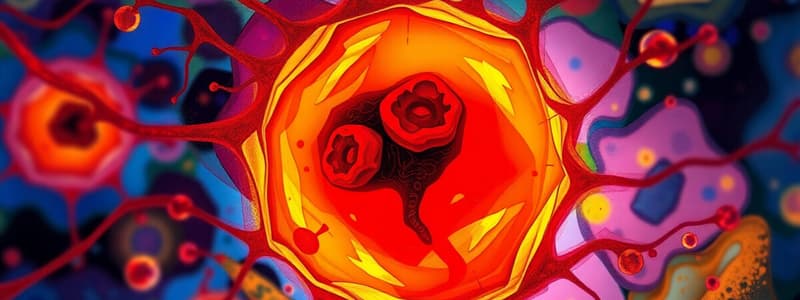Podcast
Questions and Answers
Which organ is NOT commonly affected by ischemic necrosis?
Which organ is NOT commonly affected by ischemic necrosis?
- Spleen
- Liver (correct)
- Heart
- Kidney
What characteristic shape does an acute myocardial infarction typically have?
What characteristic shape does an acute myocardial infarction typically have?
- Circular
- Irregular
- Wedge-shaped (correct)
- Triangular
What type of necrosis is primarily associated with tuberculosis?
What type of necrosis is primarily associated with tuberculosis?
- Focal necrosis
- Caseous necrosis (correct)
- Liquefactive necrosis
- Coagulative necrosis
What process describes the transformation of tissue into liquid due to ischemic injury?
What process describes the transformation of tissue into liquid due to ischemic injury?
Which of the following best describes the presence of macrophages in a liquefactive necrosis scenario?
Which of the following best describes the presence of macrophages in a liquefactive necrosis scenario?
What is the primary distinction between necrosis and apoptosis?
What is the primary distinction between necrosis and apoptosis?
Which of the following best describes hypertrophy?
Which of the following best describes hypertrophy?
What condition can lead to atrophy of the testis?
What condition can lead to atrophy of the testis?
Which type of necrosis is most commonly associated with sudden cessation of blood flow?
Which type of necrosis is most commonly associated with sudden cessation of blood flow?
Which process involves transformation of one differentiated cell type to another?
Which process involves transformation of one differentiated cell type to another?
What is the main cause of left ventricular hypertrophy?
What is the main cause of left ventricular hypertrophy?
Which condition can result from prostatic hyperplasia?
Which condition can result from prostatic hyperplasia?
Hypoxia is primarily defined as a condition of:
Hypoxia is primarily defined as a condition of:
Flashcards are hidden until you start studying
Study Notes
Cell Injury
- Cell injury occurs when cells are stressed beyond their ability to adapt, exposed to damaging agents, or affected by intrinsic abnormalities.
- Cell injury can be reversible (degeneration) or irreversible (cell death).
- Reversible cell injury leads to metabolic and morphological changes in tissues.
- Irreversible cell injury leads to cell death, which can be necrosis (unprogrammed death of a group of cells) or apoptosis (programmed death of a single cell).
Causes of Cell Injury
- Hypoxia (reduced oxygen) and ischemia (insufficient blood flow)
- Chemical agents
- Physical agents
- Infectious agents
- Nutritional disturbances
- Immunological reactions
Adaptive Cellular Responses
- Hypertrophy: Increase in cell size, leading to an increase in organ size.
- Example: Cardiac hypertrophy caused by increased workload, leading to left ventricular thickening.
- Hyperplasia: Increase in the number of cells, also leading to increased organ size.
- Atrophy: Decrease in cell size, resulting in a decrease in organ size (shrinkage).
- Example: Testis atrophy can occur due to chronic alcoholism, atherosclerosis, chemotherapy, or radiation.
- Metaplasia: Transformation of one differentiated cell type into another.
- Example: Barrett's esophagus is a metaplasia of the normal esophageal squamous mucosa into gastric-type columnar mucosa due to chronic GERD.
Necrosis
- Death of a group of cells within a living body.
- Different types of necrosis:
- Coagulative necrosis: The most common type, often caused by ischemia. Occurs in organs like the heart, kidney, and spleen.
- Example: Myocardial infarction (MI): A yellowish area of necrosis with a hyperemic border.
- Liquefactive necrosis: Cells are transformed into a liquid viscous material. Typically occurs due to ischemic injury and bacterial infections.
- Example: Infarction of the brain: Liquefactive necrosis with the formation of cystic spaces.
- Caseous necrosis: A combination of coagulative and liquefactive necrosis, characterized by a cheese-like appearance. Seen in tuberculous infections.
- Example: Tuberculosis lung: Large nodules may have central caseous necrosis.
- Fat necrosis: Seen in the pancreas, where lipase breaks down fat cells, releasing free fatty acids that combine with calcium to form soaps.
- Fibrinoid necrosis: Seen in blood vessel walls, often associated with immune reactions.
- Coagulative necrosis: The most common type, often caused by ischemia. Occurs in organs like the heart, kidney, and spleen.
Normal vs. Enlarged Prostate
- Normal prostate: Size of a walnut.
- Enlarged prostate (Prostatic hyperplasia): Obstruction of urinary outflow from the bladder, leading to obstructive uropathy.
Studying That Suits You
Use AI to generate personalized quizzes and flashcards to suit your learning preferences.




